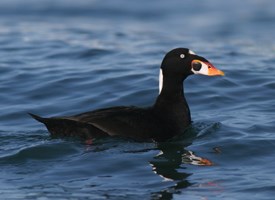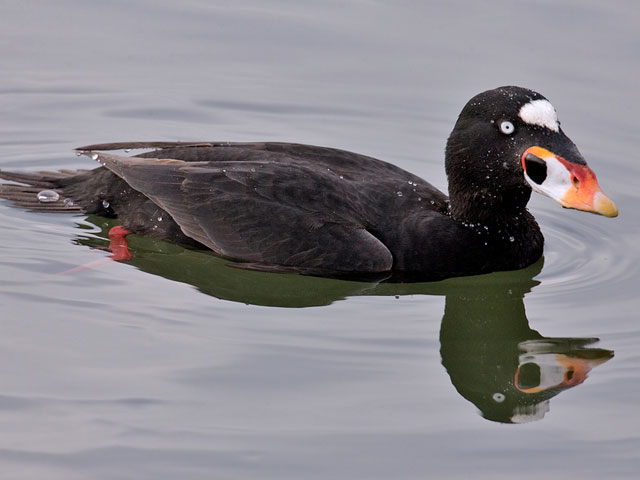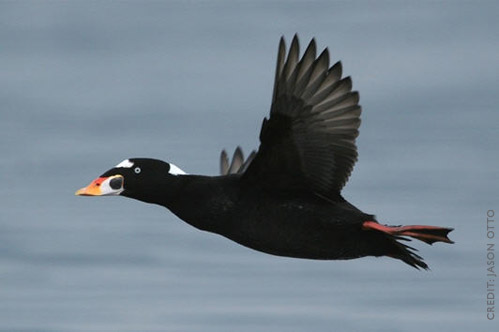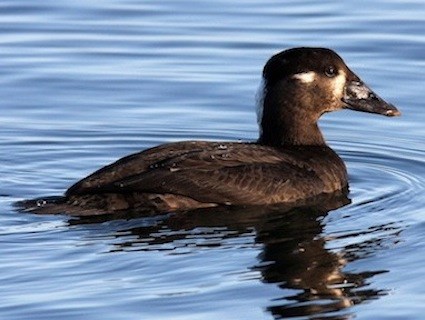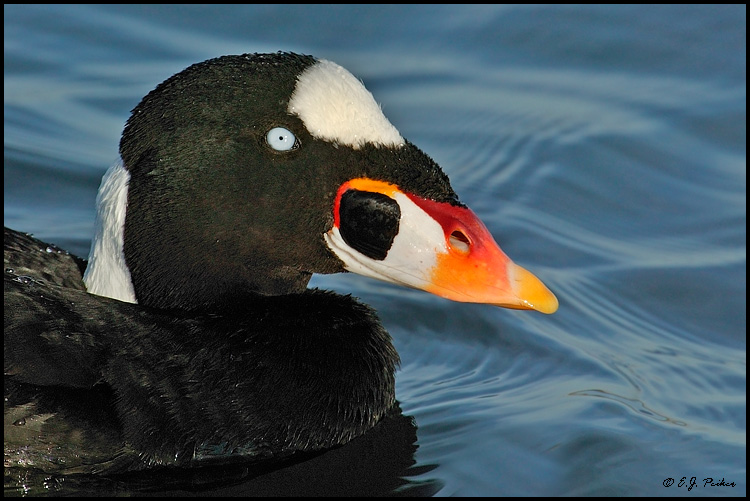Surf Scoter
Glasses Duck ( Melanitta perspicillata )
The glasses Duck ( Melanitta perspicillata ) is a native to North America monotypic sea duck. So far, no evidence has been that it also breeds in the Palearctic. However, they occasionally wintered on the northern coasts of Europe. Since 1980, about 30 individuals are observed in winter in northern Britain and Ireland. Even in France, Denmark, Norway and Finland glasses ducks are seen occasionally.
External features
The glasses duck is 46-55 cm long, 800 to 1200 g in weight and has a wingspan of 90 cm. She has a black plumage, only the males are marked by two conspicuous white spots and a black -white- red beak on the head. In the male the plumage is overall a little less shiny than is the case with the belonging to the same genus Scoter. The feet of the males are red, eyes white border. Much like the plush duck head and the glasses duck has a beak sign and the head is wedge-shaped profile. In plumage the male beak color is less contrasty. The body plumage is black soot. The white patch on the neck is still present, the white spots on the head is not.
The female is entirely blackish - brown except for two brighter points per head. The body is slightly darker than feathered head and neck. Your beak is dark gray. The legs and feet are yellow-orange. The iris is white. In plumage plumage is dark brown rather uniform. Young birds have the same plumage as the female.
In Flight resembles the glasses of common scoter duck, ducks although glasses are slightly larger. The female duck glasses can be also confused on the water swimming with the female of the eider duck. Compared to the scoter duck glasses is also slightly larger and there is a lack in the males the white sections on the wings, as it is characteristic of velvet scoter. Glasses ducks often move in large flocks. About the open sea, the flying height is very low. Overland, however, they fly much higher and fall on by their abrupt change of direction.
Glasses ducks are usually very quiet birds. Breeding males can hear a low whistle and sharp puk - puk - calls. The female calls during courtship guttural krraak - krraak. The young birds will be warned with a sharp craah of her from danger.
Dissemination
The breeding range of the glasses duck ranges from central Alaska, starting in the north to the shores of the Mackenzie. In Eastern direction it extends to the Hudson Bay and central Labrador. In the heartland of North America, the breeding range of glasses duck overlaps with that of the white-winged scoter. However, glasses ducks about 10 times as often velvet scoter. Although no subspecies are described for these breeds of ducks, the distribution is disjoint with it.
In the winter half-year, glasses ducks keep both on the coasts of the Pacific and the Atlantic, and can be observed in this period of the Great Lakes. In its eastern distribution area they wintered up to Baja California. California and Baja California, even the most important wintering areas for the Pacific population. The glasses duck comes regularly in winter in Scotland and Norway (Trondheim Fjord ) ago.
Habitat
The glasses Duck is a breeding bird in shallow lakes of small to medium size in open boreal forests. You preference is areas with high groundwater level. During the hibernation period, she retreats to the coastal waters. This removes them usually no more than a kilometer from the country and most of his time on in waters deeper than 10 meters. She often uses coasts with strong surf.
Food
The glasses duck feeds on molluscs, clams, crabs, insects and aquatic plants. During the breeding season it involves freshwater species. In the winter season and during the moulting period it holds also in coastal waters and eats there, especially mussels. Carnivorous swarms often dive in sync.
Reproduction
Breeding pairs are formed already during the overwintering period and the courtship takes place until the arrival in the breeding areas continued. It is looking to be close by one or more females to a Gruppenbalz, in which small groups of males. The females are seen here aggressively against unwanted male. Copulation takes place in the water stood; the pairs but stand out against the other glasses ducks. The breeding pairs scattered far beyond the nesting area. Most adheres to a body of water on just one breeding pair. Eggs are laid in the last weeks of May, usually just one week after arrival in the breeding areas. The eggs are cream-colored, weighing about 62 grams. A nest consists of an average of 7.6 eggs. It breeds only the female. The pair-bond of the male leaves after the first brood days strong. You generally leave the breeding females at this time.
The nest is located near water, but usually a few meters from the shore. It is well hidden among the undergrowth and often located under overhanging branches of conifers. The slack time of Dunenküken falls into the last of June until the first weeks of August. The highlight of the slip is the second week of July in the rule. The Dunenküken are precocial and leave, led by the female adult bird, usually within 24 hours of the nest. You can feed independently and do this by diving into shallow water for food. The young birds remain valid until their fledging within the family. The aggressiveness of the female Altvogels compared to similar types of young birds is a reason that it does not come to the mixing of the different ducklings droves.
Stock
For this breeding in the far north breeds of ducks insufficient inventory figures are available. The IUCN estimates the number of mature individuals of this type 250,000 to 1.3 million. They classified the species as uncritical ( least concern ), since the distribution is very large. Overall, a decreasing population trend is found primarily in North America, but were due to the Nearctic distribution of this species only fifty percent of the North American distribution area studied.
Glasses duck and human
The glasses duck is both in northern Canada and in Alaska by the indigenous population hunted ( subsistence ). This is allowed in both Canada and the United States. As more and more species of ducks are protected against this form of hunting through bans, hunting pressure increases in this way.
In November 2007, an oil spill killed in the Bay of San Francisco, thousands of glasses ducks. About 40 percent of the Pacific population were affected by this oil spill. According to scientists this oil spill did not result in a critical threat to the existence of this kind, however, he had impact on the population as a whole, since most adult healthy birds were affected, which must be counted in the breeding population.

